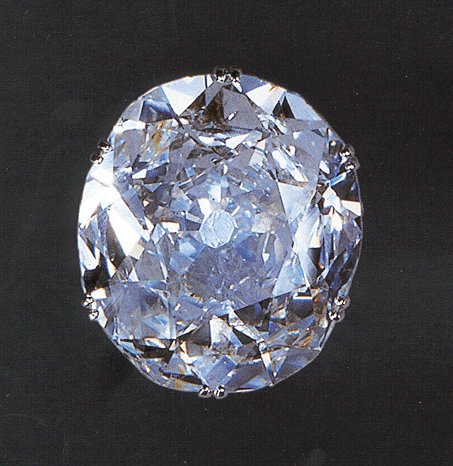 It is impossible to talk about The Moonstone without addressing the mysterious stone itself. It is described as a large yellow diamond taken from the forehead of the Hindu god of the moon. In the book it is valued at 30,000 pounds. For a time Collins considered having the stone come from a statue of a snake and the tentative title of the book was The Serpent’s Eye.
It is impossible to talk about The Moonstone without addressing the mysterious stone itself. It is described as a large yellow diamond taken from the forehead of the Hindu god of the moon. In the book it is valued at 30,000 pounds. For a time Collins considered having the stone come from a statue of a snake and the tentative title of the book was The Serpent’s Eye. In spite of the fact that the stone appears only briefly in the story before it disappears it has a long and violent history. Collins also seems to have based the stone on a number of famous diamonds. Collins took notes on gems from The Natural History of Precious Stones and Gems that had been published in 1865. Collins preface actually refers to both the Koh-i-Noor diamond and the Orloff diamond.
The Koh-i-Noor diamond (pictured at above) or "Mountain of Light" as it was called has a dark history. It was discovered in 1655 and was given to Shah Jahan, the Moghul Emperor and passed through the hands of numerous rulers. After the British military, on behalf of the East India company thwarted a Sikh uprising in 1849 the diamond was taken from Maharaja Dhulip Singh in tribute. The East India company then gave the stone to Queen Victoria on July 3, 1850 and was displayed at the great exhibition of 1851 so many of Collins readers would have seen it. Many viewers at the exhibition were disappointed by the appearance of the stone since Indian custom required the stone to be kept in its natural state. It was only after the Exhibition that the stone was cut in Amsterdam and took on the appearance above, the largest of the pieces and a "jewel of the crown." As a sacred gem the Koh-i-Noor was supposed to bring a curse on anyone who took and misused the stone.
The Orloff diamond is the other source for the moonstone and has a particularly sordid history. It was famously taken from the eye of a Brahman statue by a French soldier who was supposed to have ingratiated himself with local priests and pretended to adopt their religious beliefs before stealing the stone. It was then stolen from the soldier by a ship's Captain who sold the stone to Prince Orloff who gave the stone to Empress Catherine the II and it was placed on the imperial scepter.
The Pitt diamond is another source of material for the moonstone. Collins was a frequent guest of Sir  George Russell and heard stories of their family heirloom, the Pitt Diamond. Another potential source was the family diamond of Charles Reade which had been brought home from India by his brother. Collins apparently had one of his mistresses, Martha Rudd, copy out a passage on the Pitt diamond from The Natural History of Precious Stones and Gems. Governor Pitt was deeply afraid of the diamond being stolen that he did not sleep in the same bed twice in a row and would never give notice if he was coming to town so as not to alert anyone to the possible presence of the stone.
George Russell and heard stories of their family heirloom, the Pitt Diamond. Another potential source was the family diamond of Charles Reade which had been brought home from India by his brother. Collins apparently had one of his mistresses, Martha Rudd, copy out a passage on the Pitt diamond from The Natural History of Precious Stones and Gems. Governor Pitt was deeply afraid of the diamond being stolen that he did not sleep in the same bed twice in a row and would never give notice if he was coming to town so as not to alert anyone to the possible presence of the stone.
The Pitt diamond had its own sordid history. The man who found it cut a gash in his leg to conceal the stone. An English captain lured him onto his ship with promises of finding a buyer and took the stone and threw the man overboard. The sea captain in turn received only 1000 pounds for the stone which he quickly spent then hanged himself. The diamond was taken from Pitt by the French Regent, the Duke of Orleans who sealed the stone and other valuables in the Commune of Paris but when they went to open the seals they were found to be already opened and the diamond stolen. Aspects of this story clearly make their way into the story of the Honorable John Herncastle.
Although most scholars do not seem to suggest that the Hope diamond was used by Collins as one of his models for the Moonstone, it is worth mentioning this famous blue diamond with another complicated history which starts with it being stolen from and Indian statue and ends with the stone being cursed, although some assert that most tales of curses are fabricated to enhance the value of a gem.
The supposed mystical aspects of the diamond are also referenced in passing by Collins. Betteredge calls it a cursed diamond. The attachment to the Indians their religious ceremony and the Indians use of divination to find the stone all tie in with the curses that such famous stones are alleged to carry. Also stones were sometimes believed to be used as a means of divination
Finally, Collins becomes the source for later mystery novels involving the theft of a gem with a violent history, Most notable. Conan Doyle's Sherlock Holmes mystery The Blue Carbuncle.

No comments:
Post a Comment